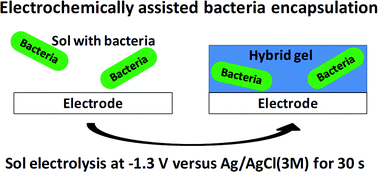Bacteria are typically cast in one of two roles: either vile, disease-causing microkillers evolving faster than science can keep up or as benevolent, yoghurt-borne wardens of the digestive system. An increasingly important third job is that of efficient, microscopic machines capable of producing complex biomolecules such as DNA or insulin, working as biosensors or acting as highly-specific catalysts.
A recent paper by Ghach et al. focuses on encapsulating bacteria in thin silica films in order to make them more practical for use in bioelectronic sensors. They developed two methods of preparing films. Firstly, a two-step process where bacteria were immobilised on an indium tin oxide (ITO) electrode before a silica-based sol was deposited over them. The second method was a one-step where the sol and the bacteria were deposited at the same time (shown above). Trehalose, poly(ethylene glycol) (PEG) and chitosan were also present in the sol to improve cell viability.
Using the two-step process, the researchers found that by varying deposition times it was possible to prepare films with a thickness between 82 nm and 2 μm. With optimum conditions, 95% cell viability was observed after one month. For the one-step process, which resulted in a composite film containing homogeneously dispersed bacteria, it was shown that encapsulated luminescent E. coli still exhibited 50% luminescence after storage for four weeks.
Electrochemically assisted bacteria encapsulation in thin hybrid sol–gel films
J. Mater. Chem. B, 2013, 1, 1052. DOI:10.1039/C2TB00421F
James Serginson is a guest web writer for the Journal of Materials Chemistry blog. He currently works at Imperial College London carrying out research into nanocomposites.
To keep up-to-date with all the latest research, sign-up to our RSS feed or Table of contents alert.











